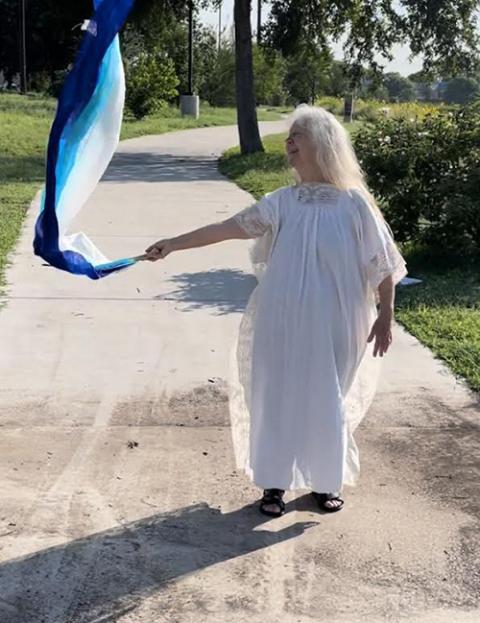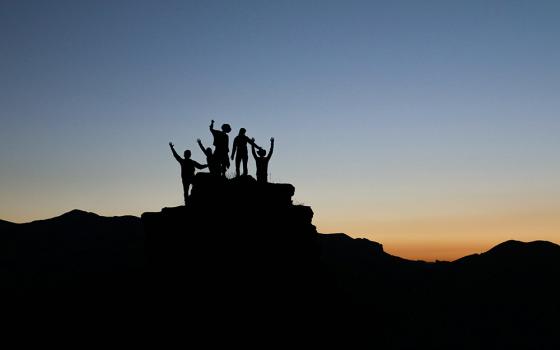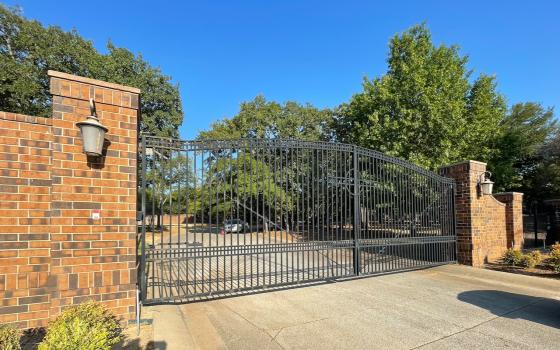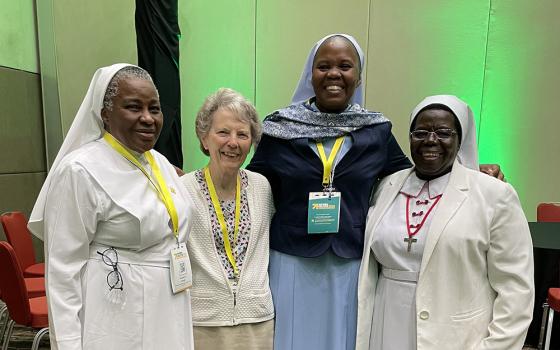
"The Water Calls, the River Crosses," danced by the Urban-15 group at Brackenridge Park in San Antonio for Global Water Dance Day, 2023 (Courtesy of Urban-15)
My children were hungry, and I took them to be with the families who have been getting food. There, the man with a kind smile was teaching people how to put the seeds in the ground. The seeds grow and there is more food. Even when no water falls from the skies and we cannot find enough acorns, nuts, berries and grasses, the people there share and have food.
Our area is semiarid, on the far edge of the Chihuahua Desert. I imagine those words as what a Coahuiltecan mother might have said in the 1700s when she brought her clan to the place where the Mission Concepción community was growing. By 1755, the community had built Mission Concepción, my parish church and the oldest unrestored stone church in the U.S. Our church is a UNESCO World Heritage Site, one of the five Spanish colonial missions founded by Spanish Franciscans.
Water links the San Antonio Missions. The Franciscans taught the hunter and gatherer clans agriculture and how to build acequias — irrigation ditches from the river to fields in order to water corn, beans, various vegetables and fruits.
Mission Concepción, Mission San José, Mission San Juan and Mission Espada are active Catholic parishes today.

At Mission Concepción in San Antonio, hundreds gather annually to dance their prayers in the Matachines Festival between the feasts of the Immaculate Conception and Our Lady of Guadalupe. (Courtesy of Martha A. Kirk)
It is my joy to help a little in educating visitors from all over the world who come to our missions. Recently, we opened the Padre Margil Pilgrimage Center.
Venerable Antonio Margil de Jesus (1657–1726) was born in Valencia, Spain, and accepted the challenge of missionary work in New Spain. His passionate love for God's people led him to walk, not ride, but walk south all the way to Guatemala. After ministering there for some years, he walked north to Louisiana. Eventually, he came to San Antonio in 1719.
He loved the Indigenous people, worked on learning their languages, and was willing to endure pain if that was needed so he might tell them of a loving God.
Recently, as I was among Indigenous people in Guatemala, I prayed remembering Margil. He had said, "Do you dare to come with me to set the world on fire?"
I was in Guatemala among the Kaqchikel families, Indigenous descendants of the Mayans. Our group of nutrition and education students from the University of the Incarnate Word in San Antonio were working with a nonprofit founded by my former students Edwin Mendoza and Darlene Jasso, the Little Angels of Mary, to promote nutrition and literacy in an area where 69% of the children under 5 are malnourished.
Advertisement
I met a Kaqchikel mother who is regularly bringing her children to be weighed and measured in the Little Angels program, which includes workshops on nutrition and building gardens. Previously her 9-month-old child had died from malnutrition.
Diarrhea leads to malnourishment. About 88% of diarrhea-associated deaths among Guatemalan children under 5 are attributable to unsafe water and insufficient hygiene.
Repeated diarrheal infections contribute to malnutrition and the high rate of stunting among Guatemalan children. The Global Water Dances initiative notes, "The United Nations has long recognized that access to fresh water is brutally unequal. Almost one billion people, roughly one person out of every eight, do not have access to clean water."
I came home and began preparing for Global Water Dances.
We dance our hopes and our prayers because the children are thirsty and hungry. We dance our hopes and our prayers because the beauty of the waters and the beauty of the dance energizes us and reminds us that we are one.
On June 10, 2023, our Global Water Dances livestreams circled the world on six continents with over 140 sites with dancers. Since 2011 these dance events have been growing biannually to raise awareness of water everywhere. "Ripples and Reflections: 10 Years of Global Water Dances" reveals the joy.
Global Water Dances linked us with the Street Children Empowerment Foundation in Accra, Ghana, where children were dancing near the sea to create awareness of water pollution.
The dances linked us to Nishinomiya, Japan, challenged by floods and tsunami.
Seven-year-old children to adults continued to participate in Global Water Dance Day in Flint, Michigan, which had a crisis of lead in the water in 2014.
In 2017, I first invited my former student Catherine Cisneros and her husband, George Cisneros, to consider participating in the Global Water Dance movement. They lead Urban-15 which invites people of all ages to be creative through music, movement, and media. They transform "through a philosophy of inclusion that breaks prejudicial barriers of size, age, gender, class, religion, ethnicity, race; targeting economic and social disparity." They create beauty that I could not have imagined.
Enter the dance. In 2017, we celebrated Global Water Dances in the Headwater Nature Sanctuary founded by our congregation, the Sisters of Charity of the Incarnate Word. Our city and our congregation had just recommitted to the Paris Climate Accord after the U.S. had withdrawn from that commitment. It seemed urgent that we make strong public statements, and dance can be such a statement.

Sr. Martha Kirk of the Sisters of Charity of the Incarnate Word dances the Water Dance. (Courtesy of Martha A. Kirk)
For Global Water Dance Day 2023, I spoke of how San Antonio started because of the water and how critical it is that we care for the waters now, since we have 2 million using the Edwards Aquifer.
On June 13, 1691, the Spanish explorer Franciscan Fr. Damian Massenet wrote, "The country is very beautiful. ... Before reaching the river, you have many groves of trees, cottonwoods, live oaks, junipers, mulberries, and many vines. There are great many fish and upon those plains many turkeys. ... I named this spot Saint Anthony of Padua because it was his day and in the Indian language it is called Yanaguana."
Massenet and those who founded and taught in our mission were followers of St. Francis of Assisi, who invited people to the beauty of creation. In Francis' "Canticle of Creation," he calls the sun, the moon, the water, the fire, the Earth, and even death, our brothers, sisters, and our mother. We live not above, but in kinship with all creatures. Water is our sister. Let us love her and dance with her.
When Pope Francis wrote a letter calling all to unite in care of our common home, the Earth, he echoed St. Francis' words: "Laudato si'," "Praise be to you."
The pope noted that "access to safe drinkable water is a basic and universal human right, since it is essential to human survival and, as such, is a condition for the exercise of other human right." Without water there is no life.
The pope mentions water 47 times in "Laudato Si', on Care for Our Common Home." He notes five main challenges: the lack of clean drinking water, food shortages if water is lacking, water-related diseases, groundwater contamination, and privatizing and commodifying water.
Global Water Dance events are calling attention to the issues that Pope Francis articulates. Will you join the dance? Will you passionately dance with brothers and sisters around the globe?








